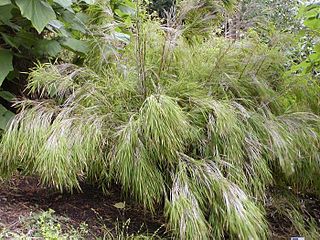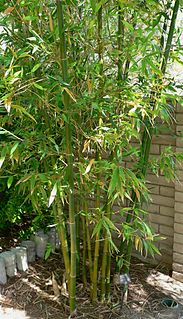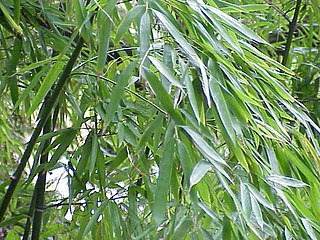
The bamboos are evergreen perennial flowering plants in the subfamily Bambusoideae of the grass family Poaceae. The word "bamboo" comes from the Dutch or Portuguese languages, which probably borrowed it from Malay.

The Mexican weeping bamboo, Otatea acuminata, is a clumping bamboo native to central and southern Mexico and Central America.

Bambusa vulgaris, common bamboo, is an open-clump type bamboo species. It is native to Indochina and to the province of Yunnan in southern China, but it has been widely cultivated in many other places and has become naturalized in several. Among bamboo species, it is one of the largest and most easily recognized.

Bambusa tulda, or Indian timber bamboo, is considered to be one of the most useful of bamboo species. It is native to the Indian subcontinent, Indochina, Tibet, and Yunnan, and naturalized in Iraq, Puerto Rico, and parts of South America.

Bambusa balcooa is a clumping bamboo native to Indochina and the Indian subcontinent. It is thick walled clumping or sympodial bamboo.

Bambusa oldhamii, known as giant timber bamboo or Oldham's bamboo, is a large species of bamboo. It is the most common and widely grown bamboo in the United States and has been introduced into cultivation around the world. It is densely foliated, growing up to 20 m tall in good conditions, and can have a diameter of up to 10 cm (4 inches).

Bambusa lako, known as Timor black bamboo, is a large species of bamboo originating from the island of Timor; its black culms may reach 21 m (69 ft) in height. A 2000 molecular study places it as closely related to the similar Indonesian species Gigantochloa atroviolacea, from which it was separated in 1997; it may soon be placed in that genus. Bambusa lako can only be grown in climates that are mostly frost free.

Dendrocalamus strictus is a bamboo species belonging to the Dendrocalamus genus. The culms (stems) are often solid. Common names include male bamboo, solid bamboo, and Calcutta bamboo.

Phyllostachys edulis, the moso bamboo, or tortoise-shell bamboo, or mao zhu, is a temperate species of giant timber bamboo native to China and Taiwan and naturalised elsewhere, including Japan where it is widely distributed south of Hokkaido. The edulis part of the Latin name refers to its edible shoots. This bamboo can reach heights of up to 28 m (92 ft). This particular species of bamboo is the most common species used in the bamboo textile industry of China, for the production of rayon.

Phyllostachys aurea is a bamboo species of the 'running bamboo' type, belonging to the diverse Bambuseae tribe. It is native to Fujian and Zhejiang in China. It is commonly known by the names fishpole bamboo, golden bamboo, monk's belly bamboo, and fairyland bamboo (Australia).

Bambusa bambos, the giant thorny bamboo, Indian thorny bamboo, spiny bamboo, or thorny bamboo, is a species of clumping bamboo native to southern Asia. It is also naturalized in Seychelles, Central America, West Indies, Java, Malaysia, Maluku, and the Philippines.

Fargesia murielae, the umbrella bamboo, is a species of flowering plant in the family Poaceae. It is a large, clump-forming evergreen bamboo, closely resembling Fargesia nitida in the same genus, but with yellow canes.

Dendrocalamus asper, also known as giant bamboo, or dragon bamboo, is a giant tropical, dense-clumping species native to Southeast Asia. Due to its common occurrence across Asia and its attractive features as well as ease of harvesting, this species has been introduced widely across Latin America and Africa. It is a sympodial or clumping bamboo that does not show lateral growth and therefore has no invasive properties.
Dendrocalamus giganteus, also known as dragon bamboo or one of several species called giant bamboo, is a giant tropical and subtropical, dense-clumping species native to Southeast Asia. It is one of the largest bamboo species in the world.
Ochlandra stridula, the Ceylon reed-bamboo, reed bamboo or forest bamboo, is a species of bamboo in the grass family). It is endemic to Sri Lanka. It can be found extensively in Ratnapura and Kegalle districts, in waste lands of rainforest and also along stream banks and I in forest gaps.
Neololeba atra, the black bamboo, is a species of tropical Asian, Australian, and Papuasian genus of bamboos in the grass family.

Bambusa polymorpha, or Burmese bamboo, is a species of clumping bamboo native to Bangladesh, Laos, Myanmar, Thailand, Sri Lanka, Java, Cuba, Puerto Rico, and Ecuador.
Dendrocalamus longispathus, the long-sheath bamboo, is a bamboo species which grows up to 20 m tall. It is native to Bangladesh, Myanmar, and Thailand. It has now become an exotic species all over the South Asia.
Melocanna baccifera is one of two bamboo species belonging to the Melocanna genus. It grows up to 10–25 m tall. It is native to Bangladesh, Myanmar, India, and Thailand.

Thyrsostachys siamensis is one of two bamboo species belonging to the genus Thyrsostachys. It grows up to 7 to 13m tall. It is native to Yunnan, Myanmar, Laos, Thailand, Vietnam and naturalised in Sri Lanka, Bangladesh, Malaysia. The plant is also known as long-sheath bamboo, monastery bamboo, Thai bamboo, Thai umbrella bamboo, umbrella bamboo, and umbrella-handle bamboo.















